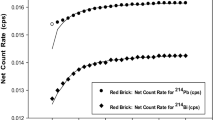Abstract
Previous studies have shown that the natural radioactivity contained in building materials have significantly influenced the dose rates in dwelling. Exposure to natural radiation in building has been of concerned since almost 80 % of our daily live are spend indoor. Thus, the aim of the study is to assess the radiological risk associated by natural radioactivity in soil based building materials to dwellers. A total of 13 Portland cement, 46 sand and 43 gravel samples obtained from manufacturers or bought directly from local hardware stores in Peninsular of Malaysia were analysed for their radioactivity concentrations. The activity concentrations of 226Ra, 232Th and 40K in the studied building materials samples were found to be in the range of 3.7–359.3, 2.0–370.8 and 10.3–1,949.5 Bq kg−1 respectively. The annual radiation dose rates (μSv year−1) received by dwellers were evaluated for 1 to 50 years of exposure using Resrad-Build Computer Code based on the activity concentration of 226Ra, 232Th and 40K found in the studied building material samples. The rooms modelling were based on the changing parameters of concrete wall thickness and the room dimensions. The annual radiation dose rates to dwellers were found to increase annually over a period of 50 years. The concrete thicknesses were found to have significantly influenced the dose rates in building. The self-absorption occurred when the concrete thickness was thicker than 0.4 m. Results of this study shows that the dose rates received by the dwellers of the building are proportional to the size of the room. In general the study concludes that concrete building materials; Portland cements, sands, and gravels in Peninsular of Malaysia does not pose radiological hazard to the building dwellers.






Similar content being viewed by others
References
UNSCEAR (2000) Exposures from Natural Radiation Sources. United Nations Scientific Committee on the Effects of Atomic Radiation. Report to General Assembly, With Annexes. United Nations, New York
UNSCEAR (1993) Sources and Biological Effects. United Nations Scientific Committee on the Effects of Atomic Radiation. Report to General Assembly, With Annexes. United Nations, New York
Ahmad N, Hussein AJA, Aslam (1998) Radiation doses in Jordanian dwellings due to natural radioactivity in construction materials and soil. J Environ Radioact 41:127–136
Papastefanou C, Stoulos S, Manolopoulou M (2005) The radioactivity of building materials. J Radioanal Nucl Chem 266(3):367–372
Yasir MS, Ab Majid A, Yahaya R (2007) Study of natural radionuclides and its radiation hazard index in malaysia building material. J Radioanal Nucl Chem 273:539–541
Aznan FI, Yasir MS, Amran Ab M, Redzuwan Y, Ismail B (2009) Radiological hazard of natural radionuclide in portland cement of peninsular malaysia. Sains Malaysiana 38:129–133
Beir VII (2006) Health risks from exposure to low levels of ionizing radiation. National academy press, Washington
ICRP (2006) Publication 99: The risk to health from exposure to low levels of ionising radiation. Elsevier, Oxford
Lucy F, Peter F, Sabine LB, Horst W, Bernd B (2002) Natural radioactivity and human mitochondrial DNA mutations. Proc Nat Acad Sci USA 99:13950–13954
Sudprasert W, Navasumrit P, Ruchirawat M (2006) Effects of low-dose gamma radiation on DNA damage, chromosomal aberration and expression of repair genes in human blood cells. Int J Hyg Environ Health 209:503–511
ICRP (2007) Publication 103: recomendation of international comission on radiological protection. Elsevier, Oxford
Manual for RESRAD-BUILD Version 3. Argonne’s Information and Publishing Division, United States
IAEA Technical Report No. 295 (1989) Measurement of Radionuclides in Food and The Environment. IAEA, Vienna
Yu C, LePoire DJ, Cheng JJ, Gnanapragasam E, Kamboj S, Arnish J, Biwer BM, Zielen AJ, Williams WA, Wallo A III, Peterson HT Jr (2003) User’s Manual for RESRAD-BUILD Version 3. Argonne’s information and publishing division, United States
Michalis T, Haralabos T, Stelios C, George C (2003) Gamma radiation measurements and dose rates in commercially-used natural tiling rocks (granites). J Environ Radioact 70:223–235
Pavlidou S, Koroneos A, Papastefanou C, Christofides G, Stoulos S, Vavelides M (2006) Natural radioactivity of granites used as building materials. J Environ Radioact 89:48–60
Aznan FI, Yasir MS, Amran Ab M, Ismail B, Redzuwan Y, Irman AR (2009) Radiological studies of naturally occurring radioactive materials in some Malaysia’s sand used in building construction. The Malays J Anal Sci 13(1):29–35
James A, Patrick T (2007) Simplified design of concrete structures, 2nd edn. J Wiley and Sons, New Jersey
Risica S, Bolzan C, Nuccetelli C (2001) Radioactivity in building materials: room model analysis and experimental methods. Sci Total Environ 272:119–126
NEA-OECD (1979) Exposure to radiation from natural radioactivity in building materials. Report by NAE group expert. OECD, Paris
Acknowledgments
The authors wish thanks to The Ministry of Science, Technology and Innovation (MOSTI), Malaysia for the Science Fund research grant with reference number 06-01-02-SF0129.
Author information
Authors and Affiliations
Corresponding author
Rights and permissions
About this article
Cite this article
Majid, A.A., Ismail, A.F., Yasir, M.S. et al. Radiological dose assessment of naturally occurring radioactive materials in concrete building materials. J Radioanal Nucl Chem 297, 277–284 (2013). https://doi.org/10.1007/s10967-012-2387-5
Received:
Published:
Issue Date:
DOI: https://doi.org/10.1007/s10967-012-2387-5




